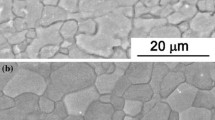Abstract
Tensile tests were conducted on pure magnesium and on four commercial alloys over a variety of temperatures and strain rates. The high positive slope of the ductility vs testing temperature curves that is found over a short range of testing temperatures for these materials was shown to result from the fact that the microstructure was not stable at these testing temperatures. Pure magnesium did not display a transition temperature, although its sub-room temperature ductility was low. This poor ductility resulted from a grain boundary weakness. The aluminum-bearing commercial magnesium alloys had a higher ductility than the pure magnesium. These alloys did exhibit a transition temperature and grain boundaries that were stronger than the grain material. Both pure magnesium and the commercial alloys began initiating cracks at strains equal to one half of their fracture strain.
Similar content being viewed by others
References
H. R. Pritchard: Correlation of Literature on the Effect of Testing Temperature on the Mechanical Properties of Wrought Magnesium Base Alloys. Project TB4-202A. Pitman-Dunn Laboratories, Frankford Arsenal. Philadelphia.
E. J. Ripling: Subzero Properties of Metals Surveyed. Iron Age (1950) 166, No. 16, p. 76; No. 17, p. 53.
G. Sachs, J. D. Lubahn, and L. J. Ebert: Notch Bar Tensile Test Characteristics of Heat Treated Low Alloy Sheets. Trans. ASM (1944) 33, p. 340.
J. L. Haughton and W. E. Prytherch: Magnesium and Its Alloys. (1938) New York. Chemical Pub. Co.
H. Vosskuhler: Die Warmfestigkeitseigenschaften der Elektron-Legierungen bei statischer Zugbeanspruchung. Metallwirtschaft (1938) 17, 6No. 35, p. 935.
F. M. Howell: Some Mechanical Properties of Currently Available Aluminum and Magnesium Alloy Products at Various Temperatures. Aluminum Research Laboratories Report 9-47-5 (June, 1947).
P. S. Jones and W. J. Worley: An Experimental Study of the Influence of Various Factors on the Mode of Fracture of Metals. Proceedings ASTM (1948) 48, p. 643.
E. J. Ripling and W. M. Baldwin, Jr.: Rheotropic Brittleness: General Behaviors. Proceedings ASTM (1951) 51, p. 1023.
E. J. Ripling: Tensile Properties and Rheotropic Behavior of Titanium Alloys and Molybdenum. WADC Report 55-5, Contract No. AF33(616)-2223 (February 1955).
F. F. Wittman and V. A. Stepanov: Influence of Deformation Speed on Cold Embrittlement of Steel. Journal of Technical Physics USSR (1939) 9, p. 1070.
J. N. Greenwood, D. R. Miller, and J. W. Suiter: Intergranular Cavitation in Stressed Metals. Acta Metallurgica (1954) 2, p. 250.
Author information
Authors and Affiliations
Additional information
E. J. RIPLING, formerly Assistant Professor, Dept. of Metallurgical Engineering, Case Institute of Technology
TP 4140E. Manuscript, Apr. 4, 1955. New York Meeting, February 1956.
Rights and permissions
About this article
Cite this article
Toaz, M.W., Ripling, E.J. Correlation of the Tensile Properties of Pure Magnesium and Four Commercial Alloys with Their Mode of Fracturing. JOM 8, 936–946 (1956). https://doi.org/10.1007/BF03377794
Published:
Issue Date:
DOI: https://doi.org/10.1007/BF03377794




